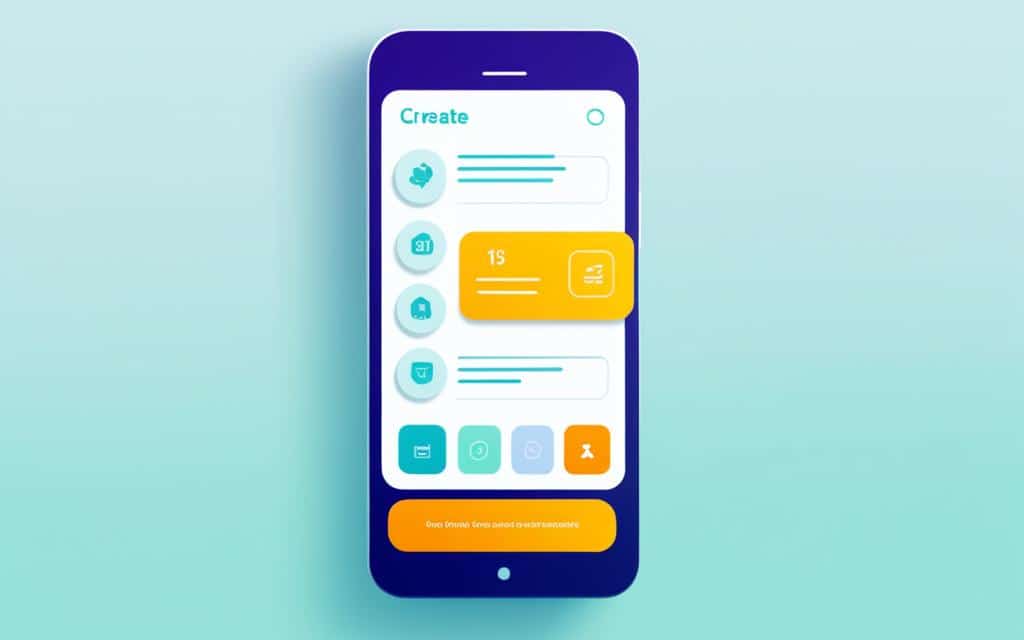Table of Contents
Welcome to our article on microinteractions and how they can enhance user experience (UX) through the use of small animations. Microinteractions are interactive moments in a user interface (UI) that provide visual feedback and guide users. By incorporating subtle animations into the design, these microinteractions make the product more intuitive, engaging, efficient, and enjoyable for users.
Microinteractions consist of four essential parts: triggers, rules, feedback, and loops/modes. When a user performs an action or interacts with a specific element, such as clicking a button or hovering over an icon, a trigger initiates the microinteraction. The rule determines the next action or response based on the trigger. The feedback component keeps the user updated during the microinteraction, providing them with visual cues and information. In some cases, loops and modes allow the microinteraction to change or adapt with repeated use, enhancing the overall user experience.
Examples of microinteractions include preloaders that indicate progress, chatbots that interact with users, gamified animations that add an element of fun, and celebratory gifs that reward users for completing a task. These small animations not only provide immediate feedback but also create a positive emotional effect, guide users through the product, encourage interaction, and prevent errors.
By incorporating microinteractions into their designs, developers and designers can significantly enhance the overall user satisfaction and engagement of a product. In the following sections, we will explore what microinteractions are, how they improve UX, the benefits they offer, best practices for designing them, and conclude with the crucial role they play in enhancing user experience. Stay tuned for an in-depth exploration of microinteractions and how they can transform your product.
What Are Microinteractions?
Microinteractions are subtle animations that support the user by giving visual feedback. They turn mundane actions into memorable moments and enhance the overall user experience (UX) by making the product more intuitive, engaging, and efficient.
Unlike large-scale animations, microinteractions are small and unobtrusive, designed to provide feedback for specific user actions. These animations can range from a simple button press effect to more complex interactions like toggling switches or progress indicators.
The purpose of microinteractions is to create a seamless and delightful user experience by making the interface feel responsive and alive. By incorporating subtle animations into the design, microinteractions make the interaction with the product more enjoyable and satisfying.
Microinteractions add a layer of interactivity and playfulness to the user interface, boosting engagement and retention. They guide users through the product, provide informative feedback, and establish a connection between the user and the interface.
Furthermore, microinteractions contribute to the overall usability of a product. By giving users visual cues and immediate feedback, they help prevent errors and guide users towards the desired actions. This reduces frustration and enhances the user’s confidence when interacting with the product.
| Microinteraction | Description |
|---|---|
| Button Press Animation | Animate button press with a subtle color change or feedback effect. |
| Form Validation | Provide real-time feedback to users when filling out forms, indicating valid or invalid input. |
| Hover Effects | Animate objects or elements when the user hovers over them, creating an interactive and engaging experience. |
| Toggle Switches | Animate switches when toggled, providing clear visual feedback. |
| Loading Spinner | Display a loading spinner animation to indicate that the system is processing a user’s request. |
Overall, microinteractions play a vital role in creating a rich and meaningful user experience. By adding these subtle animations throughout the product’s interface, designers can enhance usability, engagement, and user satisfaction.
How Do Microinteractions Help Improve UX?
Microinteractions play a vital role in enhancing the overall user experience (UX) of a product. They go beyond aesthetics and add small, subtle animations that contribute to user satisfaction, engagement, and efficiency. Let’s explore how microinteractions improve UX in various ways:
- Create a positive emotional effect: Microinteractions have the power to evoke positive emotions in users. Whether it’s a delightful animation or a satisfying sound effect, these small interactive moments leave a lasting impression and make the user experience more enjoyable.
- Provide immediate feedback: Microinteractions offer instant visual feedback, ensuring users understand the outcome of their actions. Whether it’s a button press or a swipe, microinteractions inform users that their input has been registered, reducing uncertainty and improving the overall usability of the product.
- Guide users through the product: Microinteractions act as a guiding hand, leading users through different interactions within a product. They provide clear cues, intuitive navigation, and visual prompts, making it easier for users to explore and understand the product’s functionality.
- Encourage interaction: Microinteractions encourage users to interact more with the product. By adding small animations or gamified elements, they create a sense of curiosity and playfulness, enticing users to engage further and discover hidden features.
- Prevent user errors: Microinteractions can help prevent user errors by offering real-time validation and proactive warnings. For example, a form validation microinteraction can highlight incorrect input fields before submission, reducing frustration and ensuring a smoother user experience.
By incorporating microinteractions into their designs, UX designers can significantly enhance the overall user satisfaction and engagement. These small but impactful animations add depth, intuitiveness, and enjoyment to the user experience, making the product more memorable and user-friendly.
How Do Microinteractions Work?
Microinteractions play a vital role in enhancing user experience by providing small, interactive moments that engage and guide users. Understanding how microinteractions work is essential for designing effective and intuitive interactions. Microinteractions can be broken down into four key parts: trigger, rule, feedback, and loops/modes.
Trigger
The trigger is the initial action that initiates a microinteraction. It can be a button click, a swipe gesture, or any other user action that prompts the microinteraction to begin. The trigger serves as the starting point for the interaction, indicating to the user that something is about to happen.
Rule
Once triggered, microinteractions follow a set of rules that determine the subsequent action or behavior. These rules define what happens after the trigger and guide the interaction towards a specific outcome. They provide structure and logic to ensure a seamless and intuitive user experience.
Feedback
Feedback is a crucial component of microinteractions as it keeps users informed and engaged throughout the interaction. It provides visual or auditory cues that indicate the progress, status, or result of the microinteraction. Feedback can be in the form of animations, sounds, or changes in the interface, providing users with real-time information about their actions.
Loops and Modes
Microinteractions can incorporate loops and modes to add complexity and variety to the interaction. Loops define the repeated behavior or animation that occurs during the interaction, creating a sense of continuity and rhythm. Modes, on the other hand, introduce variations or states within the microinteraction, allowing users to interact with different functionalities or options.
By understanding these four components of microinteractions – trigger, rule, feedback, and loops/modes – designers can create engaging and intuitive interactions that enhance the overall user experience. When implemented effectively, microinteractions can make even the smallest actions feel meaningful and memorable.
Benefits of Microinteractions
Microinteractions offer numerous benefits for enhancing user experience. Incorporating these small yet impactful animations into a product can result in:
- Positive Emotional Effect: Microinteractions create delightful moments that evoke positive emotions in users, making the overall experience more enjoyable and memorable.
- Immediate Feedback: With microinteractions, users receive real-time visual feedback, providing reassurance that their actions have been acknowledged and understood by the interface.
- Guidance for Users: Microinteractions act as subtle guides, helping users navigate through a product by providing intuitive cues and directing their attention to essential elements and actions.
- Encouragement of Interaction: By incorporating microinteractions, designers can incentivize users to explore and engage with the product, enhancing user involvement and fostering a sense of exploration.
- Error Prevention: Microinteractions can effectively prevent user errors by providing contextual hints, warnings, and alerts, ensuring users’ interactions align with their intended goals and reducing frustration.
By leveraging microinteractions, designers can significantly enhance overall user satisfaction, engagement, and retention. Integrating these subtle animations into the user interface brings life and interactivity, making digital experiences more enjoyable and intuitive.
Best Practices for Designing Microinteractions
When it comes to designing microinteractions, following best practices is crucial to ensure a seamless user experience. A well-designed microinteraction can make all the difference in enhancing user engagement and satisfaction. Here are some key principles to consider:
User-Centered Design
Design microinteractions with the user in mind. Understand their needs, preferences, and behavior to create interactions that are intuitive and meaningful. Conduct user research and usability testing to gather valuable insights and refine your designs.
Clarity and Consistency
Microinteractions should be clear and consistent throughout the user journey. Use visual cues, animations, and feedback that align with the overall design language of the product. Consistency builds trust and familiarity, making the interactions more intuitive.
Performance Optimization
Optimize the performance of your microinteractions to ensure smooth and responsive animations. Minimize loading times and prioritize performance to provide a seamless experience for users. Consider techniques like lazy loading and animation optimization for better performance.
Feedback and Affordances
Microinteractions should provide immediate feedback to users, confirming their actions and guiding them through the interaction. Use visual cues, tooltips, and animations to communicate system status and affordances, making the interaction more intuitive and understandable.
Storytelling and Branding
Create microinteractions that align with your brand identity and tell a story. Incorporate your brand’s visual elements, color palette, and tone of voice to reinforce brand recognition and create a cohesive user experience.
Accessibility
Ensure that your microinteractions are accessible to all users, including those with disabilities. Use appropriate color contrast, provide alternative text for non-text elements, and adhere to accessibility guidelines to make your microinteractions inclusive.
Testing and Iteration
Test your microinteractions with real users and gather their feedback to identify areas for improvement. Iterate on your designs based on user insights to refine and optimize the microinteractions over time.
Contextual Relevance
Design microinteractions that are contextually relevant to the user’s current task or situation. Tailor the interactions to match the user’s needs, preferences, and goals, providing a personalized and efficient user experience.
Consideration of Technical Constraints
Understand the technical constraints and limitations of the platform or device where your microinteractions will be implemented. Consider factors such as screen size, processing power, and available resources to ensure optimal performance and compatibility.
By following these best practices, you can design microinteractions that enhance the user experience, making your product more engaging, intuitive, and efficient.
Conclusion
Microinteractions play a pivotal role in enhancing the user experience by incorporating small, subtle animations that make the product more engaging, intuitive, and efficient. By adhering to best practices and considering the needs of users, designers can create microinteractions that delight users and contribute to a positive user experience.
Microinteractions, such as preloaders, chatbots, gamified animations, and celebratory gifs, provide visual feedback and guide users through the product. These small interactive moments in UI transform mundane actions into memorable experiences, making the overall user journey more enjoyable.
With their ability to create a positive emotional effect, provide immediate feedback, guide users, encourage interaction, and prevent errors, microinteractions significantly enhance user satisfaction and engagement. When thoughtfully designed, microinteractions make the product more user-centered, intuitive, and encourage deeper interaction and exploration.
By focusing on user-centered design, clarity and consistency, performance optimization, feedback and affordances, storytelling and branding, accessibility, testing and iteration, contextual relevance, and technical constraints, designers can maximize the potential of microinteractions, resulting in an enhanced user experience and long-lasting user engagement.
FAQ
What are microinteractions?
Microinteractions are small interactive moments in UI that provide visual feedback and guide users. They enhance UX by making the product more intuitive, engaging, efficient, and enjoyable. Examples include preloaders, chatbots, gamified animations, and celebratory gifs.
How do microinteractions help improve UX?
Microinteractions improve UX by creating a positive emotional effect, providing immediate feedback, guiding users through the product, encouraging interaction, and preventing user errors. They contribute to overall user satisfaction and engagement.
How do microinteractions work?
Microinteractions consist of four parts: trigger, rule, feedback, and loops/modes. The trigger is the first part that initiates the microinteraction. The rule determines the next action after the trigger. Feedback keeps the user updated during the microinteraction. Loops and modes define the meta-rules and how the microinteraction changes with repeated use.
What are the benefits of microinteractions?
Microinteractions create a positive emotional effect, provide immediate feedback, guide users, encourage interaction, and prevent errors. Incorporating microinteractions into a product can significantly enhance overall user satisfaction and engagement.
What are the best practices for designing microinteractions?
Designing effective microinteractions requires user-centered design, clarity and consistency, performance optimization, feedback and affordances, storytelling and branding, accessibility, testing and iteration, contextual relevance, and consideration of technical constraints.













